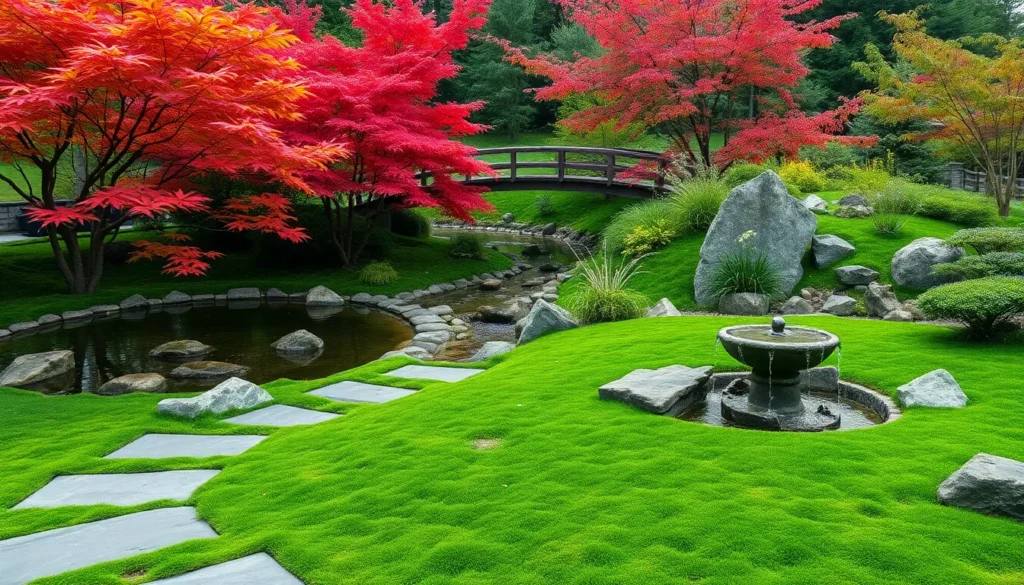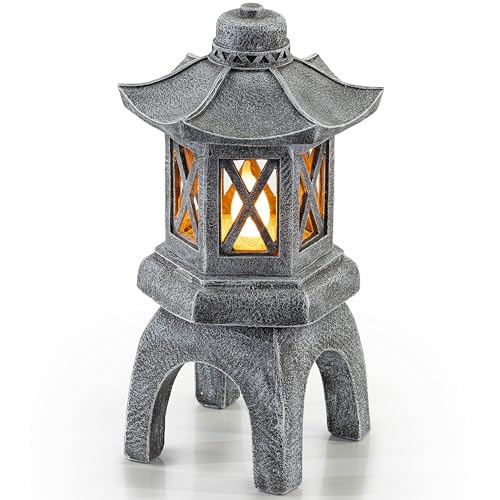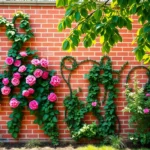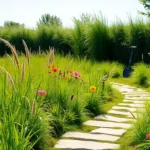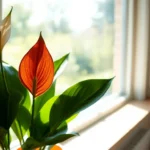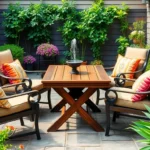Creating a Japanese garden transforms any outdoor space into a tranquil sanctuary that reflects centuries of design philosophy and natural harmony. We’re diving into the art of Japanese landscaping where every element serves a purpose and every detail tells a story of balance between human creativity and nature’s wisdom.
Whether you’re working with a sprawling backyard or a compact urban space we’ll explore versatile ideas that capture the essence of traditional Japanese garden design. From the gentle sound of water features to the strategic placement of stones and the careful selection of plants these gardens offer more than just visual appeal—they provide a peaceful retreat from our busy modern lives.
We’ll guide you through practical design elements that make Japanese gardens so captivating including rock arrangements meditation spaces bamboo features and plant selections that thrive in various climates. Let’s discover how to bring this timeless aesthetic to your own outdoor sanctuary.
Create a Tranquil Water Feature for Your Japanese Garden
Water features serve as the heart of authentic Japanese garden design, bringing movement and sound that enhance the meditative atmosphere. We’ll explore three essential water elements that transform ordinary spaces into peaceful retreats.
Install a Koi Pond With Natural Stone Edges
Koi ponds create stunning focal points that combine living beauty with serene water surfaces. We recommend excavating a pond measuring 6-8 feet in diameter and 3-4 feet deep to provide adequate space for koi fish to thrive.
Natural fieldstone or granite boulders work best for pond edges, creating organic transitions between water and surrounding industry. Place larger stones first as anchors, then fill gaps with medium and smaller stones to achieve a weathered, natural appearance that mimics mountain streams.
Water circulation systems ensure healthy conditions for koi while preventing stagnation. Install a biological filter rated for your pond’s volume and add a UV sterilizer to control algae growth naturally.
Consider adding aquatic plants like water lilies and lotus to provide shade and natural filtration. These plants reduce maintenance requirements while creating authentic Japanese garden aesthetics that complement the swimming koi.
Add a Bamboo Water Fountain for Gentle Sounds
Bamboo water fountains deliver the distinctive sounds that define Japanese gardens through their rhythmic filling and tipping action. We suggest using 4-6 inch diameter bamboo sections cut to 18-24 inches in length for optimal water flow and sound production.
Position your bamboo fountain near seating areas to maximize the calming effects of gentle water sounds. Mount the bamboo spout on a sturdy wooden or stone base that allows for proper pivoting motion as water accumulates and releases.
Recirculating pump systems work efficiently for bamboo fountains, requiring only a small reservoir hidden beneath decorative river rocks. Connect flexible tubing from the pump to the bamboo spout, ensuring steady water flow that maintains consistent sound patterns.
Surround your bamboo fountain with ferns, moss, and shade loving plants that thrive in the humid microclimate created by flowing water. This natural grouping enhances the fountain’s integration within your overall garden design.
Design a Small Stream With River Rocks
Small streams create ever-changing water movement that connects different garden areas while providing soothing background sounds. We recommend planning stream courses that follow natural contours and incorporate gentle curves rather than straight lines for authentic appearance.
River rocks ranging from 2-8 inches in diameter work best for stream beds, creating varied textures and natural water flow patterns. Layer smaller pebbles between larger rocks to prevent erosion while maintaining clear water flow.
Elevation changes of 6-12 inches per 10 feet of stream length create gentle cascades that enhance sound and visual interest. Use flat stones as natural stepping platforms and larger boulders as accent features along the stream’s path.
Moisture loving plants like hostas, astilbe, and Japanese painted ferns thrive alongside streams, creating lush borders that soften hardscape elements. These plantings also help stabilize soil and prevent erosion during heavy rainfall periods.
Design Pathways Using Traditional Japanese Materials
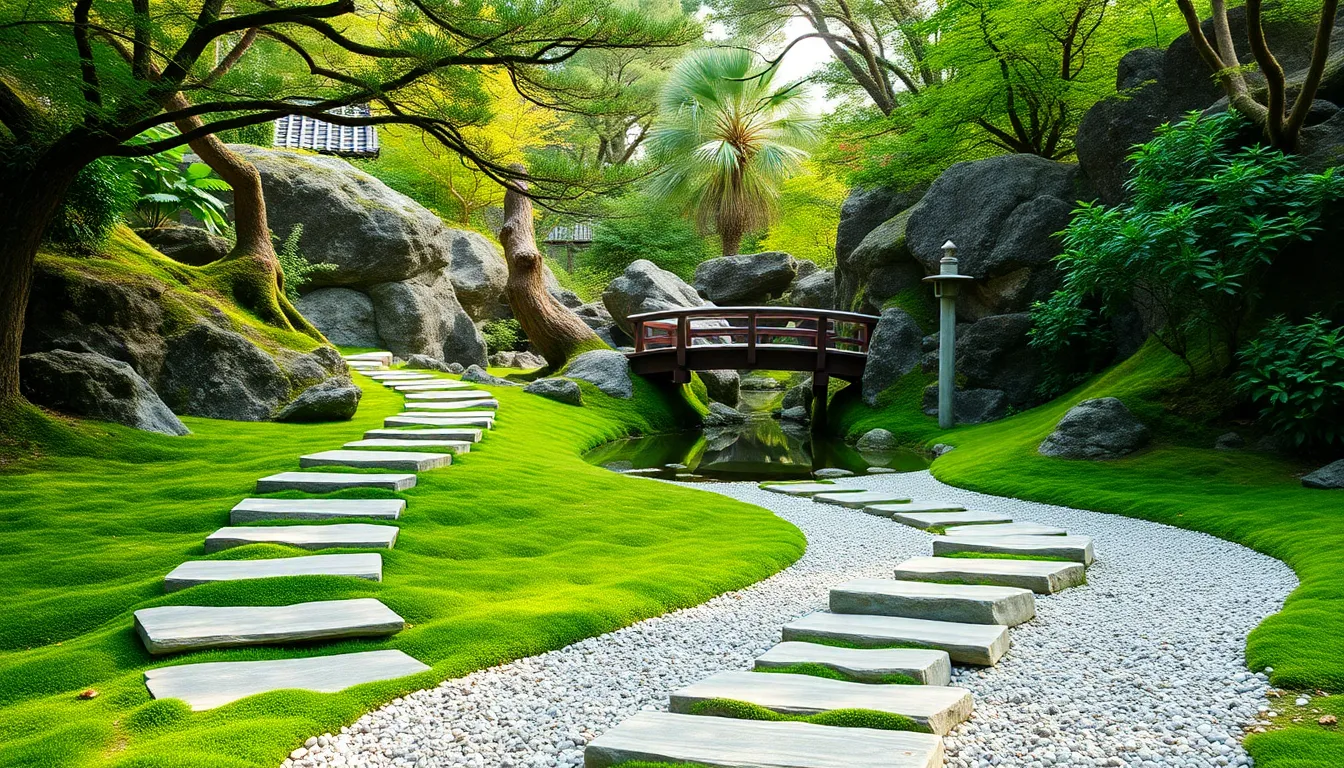
Pathways form the spiritual backbone of any authentic Japanese garden, guiding visitors through a meditative journey while connecting different elements seamlessly. These carefully crafted routes use natural materials that reflect centuries of design philosophy.
Lay Stepping Stones Across Moss and Gravel
Stepping stones create the most iconic pathway element in Japanese garden design, offering both practical navigation and symbolic meaning. We recommend placing flat stones with irregular shapes at comfortable walking intervals, typically 24 to 30 inches apart for optimal stride length.
Natural moss growth between stones enhances the organic feel while providing soft contrast to hard surfaces. Areas with partial shade work best for moss development, requiring consistent moisture without waterlogging the soil beneath.
Gravel sections complement stepping stones by creating textural variety and representing water in traditional Zen philosophy. We suggest using fine gravel in neutral tones like gray or beige, raked in subtle patterns that flow around each stone placement.
Position stones with slight variations in height and angle to mimic natural rock formations found in mountain streams. This technique prevents the pathway from appearing artificially uniform while maintaining safe footing for garden visitors.
Create Curved Walkways With Natural Flagstone
Curved walkways embody the Japanese principle of avoiding straight lines, which are considered harsh and unnatural in traditional design philosophy. Natural flagstone provides an ideal material for these gentle curves, offering durability and authentic texture.
Choose flagstones with varied sizes and natural edges rather than perfectly cut pieces to maintain the organic aesthetic. We recommend stones measuring 18 to 36 inches in diameter for comfortable walking surfaces that feel substantial underfoot.
Install flagstones with slight gaps between each piece, allowing small plants or moss to establish naturally in the joints. These living elements soften the hardscape while reinforcing the garden’s connection to nature.
Curve pathways around existing trees, rock formations, or water features to create discovery moments throughout the garden journey. This approach follows the Japanese concept of “hide and reveal,” where each turn offers new perspectives and experiences.
Build Wooden Bridges Over Water Elements
Wooden bridges serve as both functional crossings and symbolic transitions between different garden spaces, representing the journey from the material industry to spiritual enlightenment. Traditional Japanese bridges use weathered cedar or cypress wood that develops beautiful patina over time.
Design bridges with gentle arches or simple flat spans depending on the water feature’s scale and your garden’s overall aesthetic. Arched bridges work well over wider streams or ponds, while flat bridges suit narrow water channels or dry creek beds.
Construct railings using natural wood posts connected with horizontal slats or rope details that complement the bridge’s style. Keep railing heights around 36 inches for safety while maintaining unobstructed views of surrounding garden elements.
Position bridges strategically to frame scenic views like waterfalls facing toward moonrise directions, following traditional placement principles that enhance the garden’s symbolic meaning. This orientation creates optimal viewing opportunities during evening meditation sessions.
Incorporate Essential Plants for Authentic Japanese Aesthetics
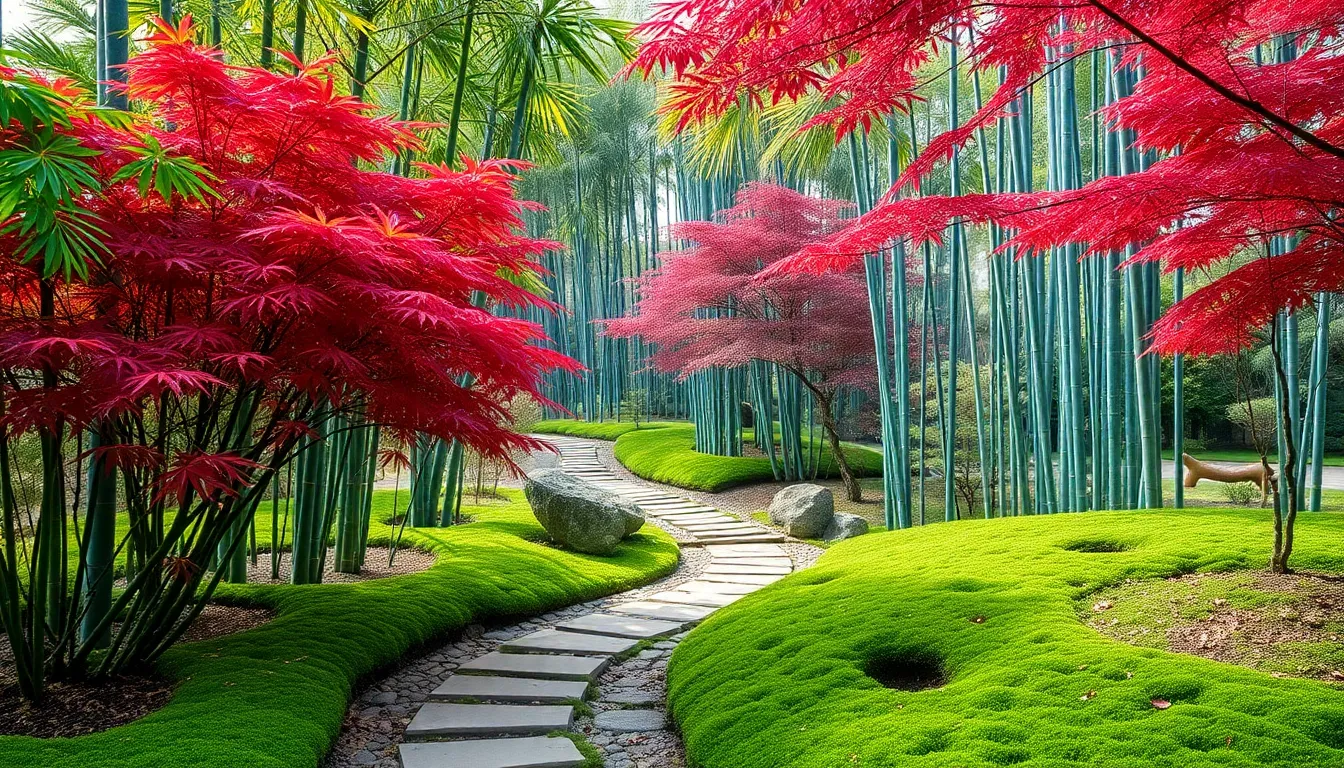
Selecting the right plants forms the foundation of our Japanese garden design. These carefully chosen species create the serene atmosphere and visual harmony that define traditional Japanese landscapes.
Plant Japanese Maples for Stunning Seasonal Color
Japanese maples serve as the crown jewels of our garden design, offering vibrant hues that transform throughout the year. We’ll witness brilliant reds, oranges, and yellows emerge in spring as new leaves unfold, while fall brings even more dramatic color displays that create stunning focal points.
Position these maples strategically near our pathways or water features to maximize their visual impact. Their delicate, palmate leaves create dappled shade patterns that enhance the garden’s tranquil ambiance. We can choose from varieties like ‘Bloodgood’ for deep red foliage or ‘Emperor I’ for consistent seasonal color changes.
Plant spacing becomes crucial for optimal growth, with most Japanese maples requiring 6-10 feet of clearance from other trees. Their slow growth rate means we’ll enjoy decades of beauty without overwhelming maintenance needs.
Add Bamboo Groves for Privacy and Movement
Bamboo groves provide both functional privacy screening and the soothing sounds of rustling leaves in our Japanese garden sanctuary. We should select clumping bamboo varieties rather than running species to prevent unwanted spreading throughout our industry.
Vertical lines created by bamboo culms add architectural interest while serving as effective windbreaks for our garden spaces. These groves work particularly well when planted at least 6 feet tall for proper privacy screening, though taller varieties create more enclosed, intimate feelings.
Movement becomes a key design element as bamboo sways gently in breezes, creating ever-changing visual interest that contrasts beautifully with static stone features. We can plant bamboo along property boundaries or use it to create separate garden rooms within larger spaces.
Maintenance requirements remain minimal for most bamboo species, making them practical choices for busy gardeners who want maximum impact with minimal effort.
Include Moss Groundcover for Serene Green Carpets
Moss groundcover transforms bare soil into lush, emerald carpets that embody the peaceful essence of Japanese garden design. We’ll find that moss thrives in shaded areas beneath our trees and alongside our stone features, creating seamless transitions between different garden elements.
Establishment occurs naturally in humid environments, though we can encourage growth by misting areas regularly during dry periods. Moss requires no mowing, fertilizing, or traditional lawn maintenance, making it an eco-friendly alternative to conventional grass.
Texture variations in different moss species allow us to create subtle visual interest across our garden floor. Some varieties form dense, cushiony mats while others create more delicate, feathery appearances that complement our stone arrangements.
We can enhance moss growth by maintaining consistent moisture levels and providing adequate shade through our tree canopy or bamboo plantings.
Establish Focal Points With Traditional Garden Structures
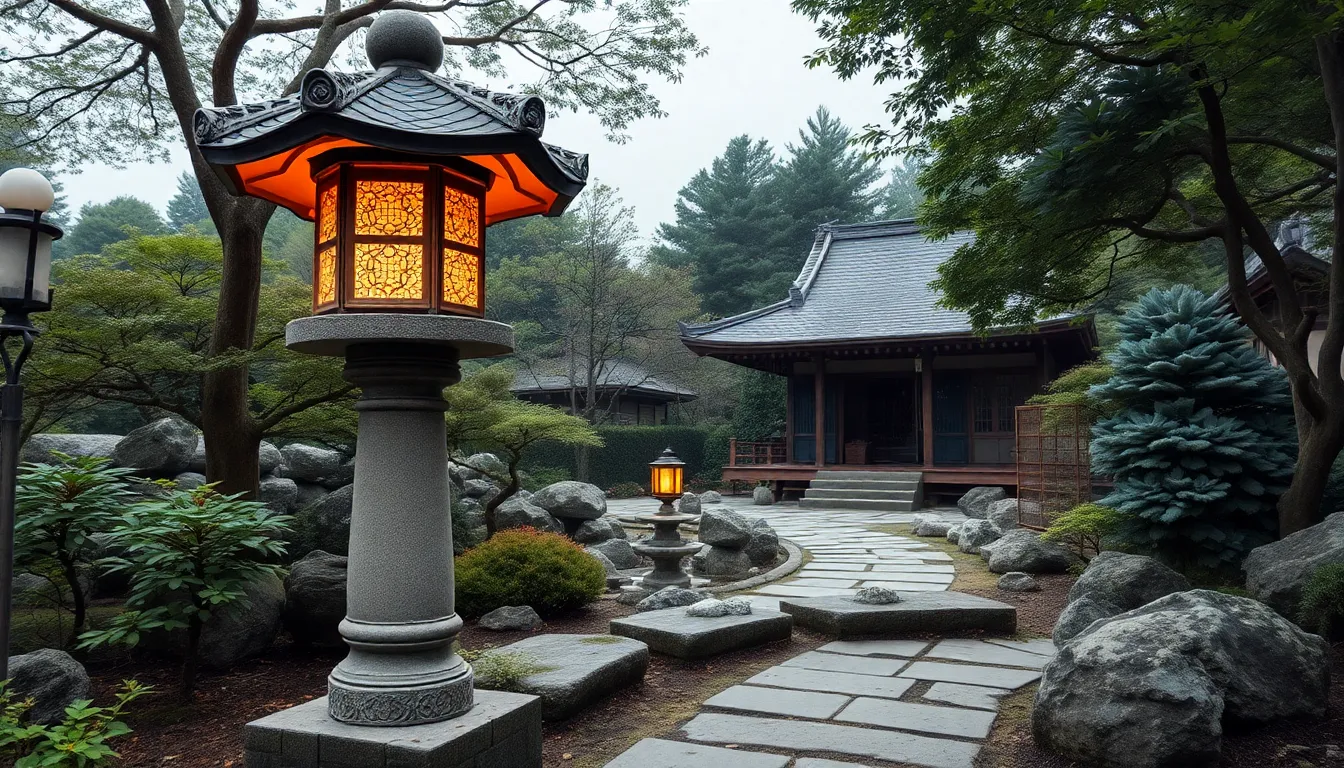
Strategic placement of traditional structures transforms our Japanese garden from a simple industry into an immersive cultural experience. These architectural elements serve as visual anchors that guide visitors through meaningful garden spaces.
Position Stone Lanterns Along Pathways
Stone lanterns create intimate lighting points that enhance our garden’s evening ambiance while honoring centuries of Japanese tradition. We should position these sculptural elements at key intervals along pathways to naturally guide visitors through different garden areas. Placement near water features or beneath maple branches creates dramatic shadows that shift throughout the day.
Traditional stone lanterns work best when positioned asymmetrically rather than in perfect rows, mimicking natural industry patterns. We can choose from several authentic styles including tall Tachi-gata lanterns for prominent positions or smaller Yukimi-gata snow viewing lanterns near water elements. The soft glow these lanterns provide transforms our garden into a magical evening retreat perfect for quiet contemplation.
Install a Tea House or Meditation Pavilion
Tea houses provide our Japanese garden with an authentic focal point that serves both aesthetic and functional purposes. We should position these structures to overlook our most beautiful garden views while maintaining harmony with surrounding industry elements. Simple wooden construction using natural materials like bamboo and cedar creates the most authentic appearance.
Design considerations include elevated positioning for better garden views and strategic placement near water features for enhanced tranquility. We can incorporate traditional elements like tatami flooring, sliding screens, and low seating to create an authentic meditation space. This peaceful retreat becomes the perfect spot for morning tea ceremonies or evening reflection sessions.
Place Decorative Garden Gates at Entrances
Decorative gates establish our Japanese garden’s boundaries while creating anticipation for the serene experience within. We should select gates that complement our garden’s overall design theme, whether traditional wooden structures or minimalist bamboo panels. Positioning gates at natural transition points helps define separate garden areas and creates a sense of journey.
Traditional gate styles include simple wooden frames with bamboo inserts or more elaborate designs featuring curved rooflines and decorative metalwork. We can enhance gate placement with flanking stone pillars or surrounding plantings that frame the entrance beautifully. These entrance structures create immediate visual impact while signaling visitors to slow down and prepare for a contemplative garden experience.
Arrange Rocks and Stones Following Zen Principles
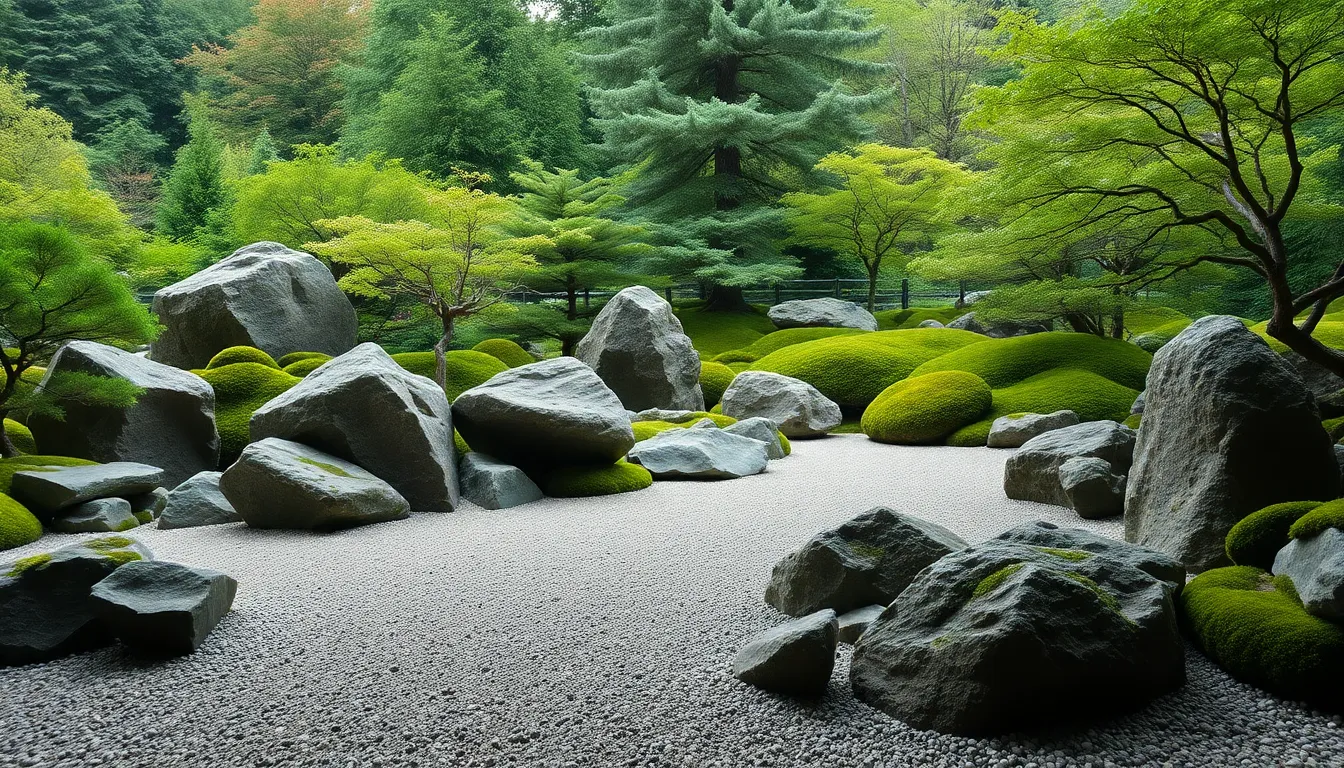
We’ll create the spiritual foundation of our Japanese garden through thoughtful stone placement that reflects centuries of Zen philosophy. These rock arrangements serve as the garden’s meditation anchors, guiding us toward inner peace through their natural harmony.
Create Rock Gardens With Carefully Placed Boulders
Boulders become powerful symbols of mountains and islands when we position them strategically throughout our garden space. We should select weathered stones with natural character, grouping them in odd numbers to avoid rigid symmetry that disrupts the organic flow.
Placement of larger boulders in the foreground creates depth while smaller stones recede into the background, mimicking nature’s perspective patterns. Moss beds and soil provide the perfect foundation for these boulder clusters, allowing each stone to settle naturally into the industry.
Asymmetrical arrangements work best because they mirror how rocks appear in wild mountain settings. We can achieve this authentic look by varying the heights and angles of our boulders, creating visual interest without overwhelming the space.
Design Dry Landscapes Using Raked Gravel
Karesansui gardens offer us the ultimate expression of minimalist beauty through carefully raked gravel that represents flowing water or drifting clouds. Fine gravel or sand becomes our canvas for creating patterns that change with the seasons and our contemplative moods.
Raking techniques should follow natural water flow patterns, with gentle curves and swirls that suggest movement without chaos. We can place strategic rocks within these gravel areas to represent islands emerging from imaginary seas.
Regular maintenance of our raked patterns reinforces the meditative purpose of this garden style. Different raking designs throughout the year keep the space ever-changing while maintaining its peaceful essence.
| Raking Pattern | Symbolic Meaning | Best Season |
|---|---|---|
| Concentric circles | Ripples around stones | Spring |
| Parallel lines | Calm water flow | Summer |
| Curved swirls | Ocean waves | Fall |
| Simple straight lines | Still pond surface | Winter |
Build Stone Retaining Walls for Terraced Areas
Stone retaining walls provide essential structure for sloped gardens while creating distinct planting zones that prevent soil erosion. Natural, irregular stones work better than manufactured blocks because they blend seamlessly with the organic garden aesthetic.
Terraced platforms give us opportunities to showcase different garden elements at varying elevations, from moss gardens to small shrub collections. We should stack stones without mortar when possible, allowing plants to grow between the gaps for a softer appearance.
Integration with the overall garden design means our retaining walls complement rather than dominate the industry. Varying wall heights creates visual rhythm while serving practical drainage and soil retention functions.
Add Seasonal Interest With Flowering Trees and Shrubs
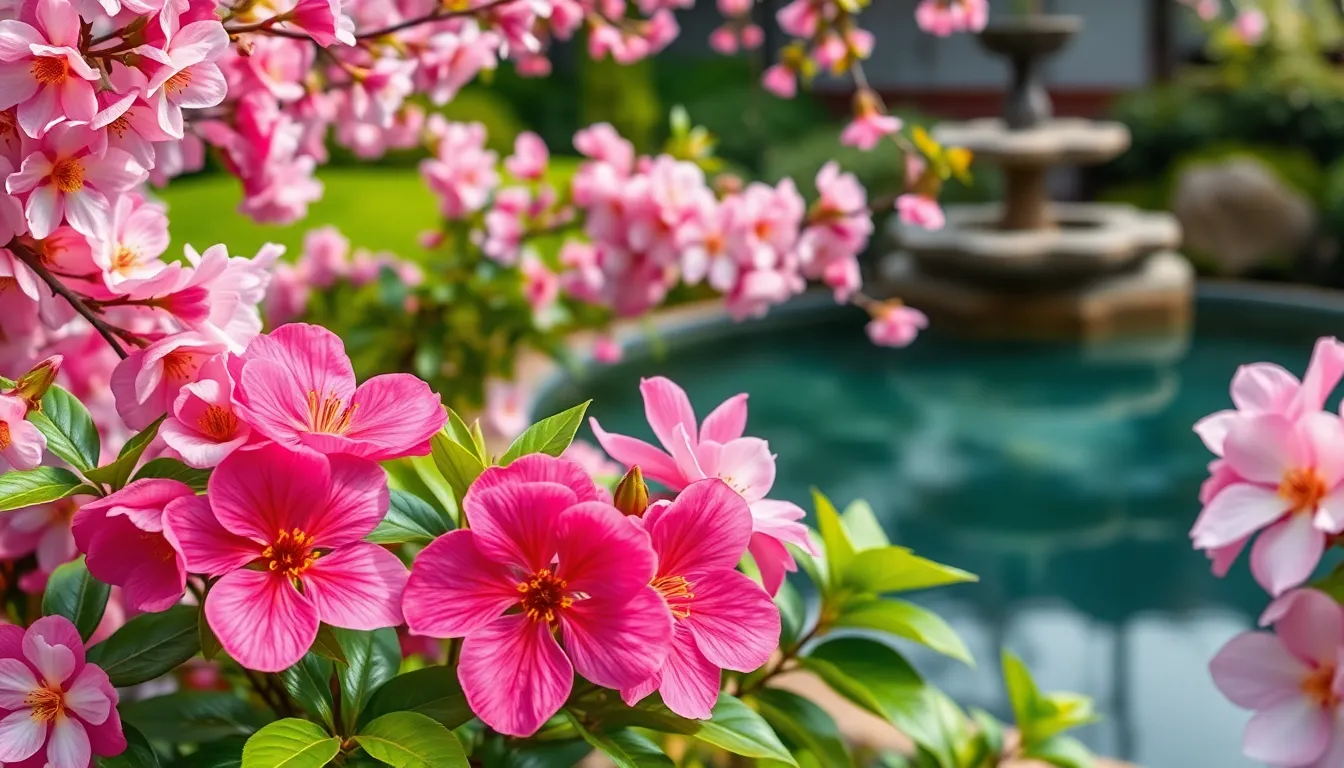
Creating continuous visual appeal throughout the year requires thoughtful selection of flowering plants that bloom at different times. We’ve identified three exceptional choices that provide stunning displays across multiple seasons.
Plant Cherry Blossoms for Spring Beauty
Cherry blossoms transform any Japanese garden into a breathtaking sanctuary during their brief but spectacular blooming period. We recommend positioning these trees near water features or meditation areas where their delicate pink petals can float gracefully onto the surface below. Flowering cherry varieties like Prunus serrulata and Prunus subhirtella offer the most authentic experience with their traditional five-petaled blooms.
Timing becomes crucial when planning your cherry blossom display since most varieties bloom for only two to three weeks in early to mid spring. We suggest planting multiple cultivars with staggered bloom times to extend the flowering season. Strategic placement along pathways creates natural viewing corridors where visitors can appreciate the flowers’ ephemeral beauty while walking through the garden.
Include Azaleas for Vibrant Color Displays
Azaleas provide explosive bursts of color that bridge the gap between spring cherry blossoms and summer greenery. We prefer Kurume azaleas for their compact growth habit and reliable blooming performance in late spring and early summer. These hardy shrubs produce masses of small flowers in shades ranging from pure white to deep crimson.
Positioning azaleas beneath taller trees creates layered plantings that mimic natural forest understories found in traditional Japanese landscapes. We recommend grouping odd numbers of plants together for the most authentic appearance. Evergreen azalea varieties maintain their foliage year round while deciduous types offer additional seasonal interest through their fall color changes.
Grow Japanese Camellias for Winter Blooms
Japanese camellias extend flowering interest well into the winter months when most other plants remain dormant. We particularly value Camellia japonica varieties for their durable winter blooms that can withstand frost and snow while maintaining their elegant form. These evergreen shrubs produce waxy flowers in white, pink, and red tones from late fall through early spring.
Placement in partially shaded areas protects camellia blooms from harsh winter winds while ensuring adequate light for healthy growth. We suggest using camellias as anchor plants near seating areas where their winter flowers can be appreciated up close. Their glossy evergreen leaves provide year round structure and backdrop for seasonal plantings throughout the garden.
Design Intimate Seating Areas for Contemplation
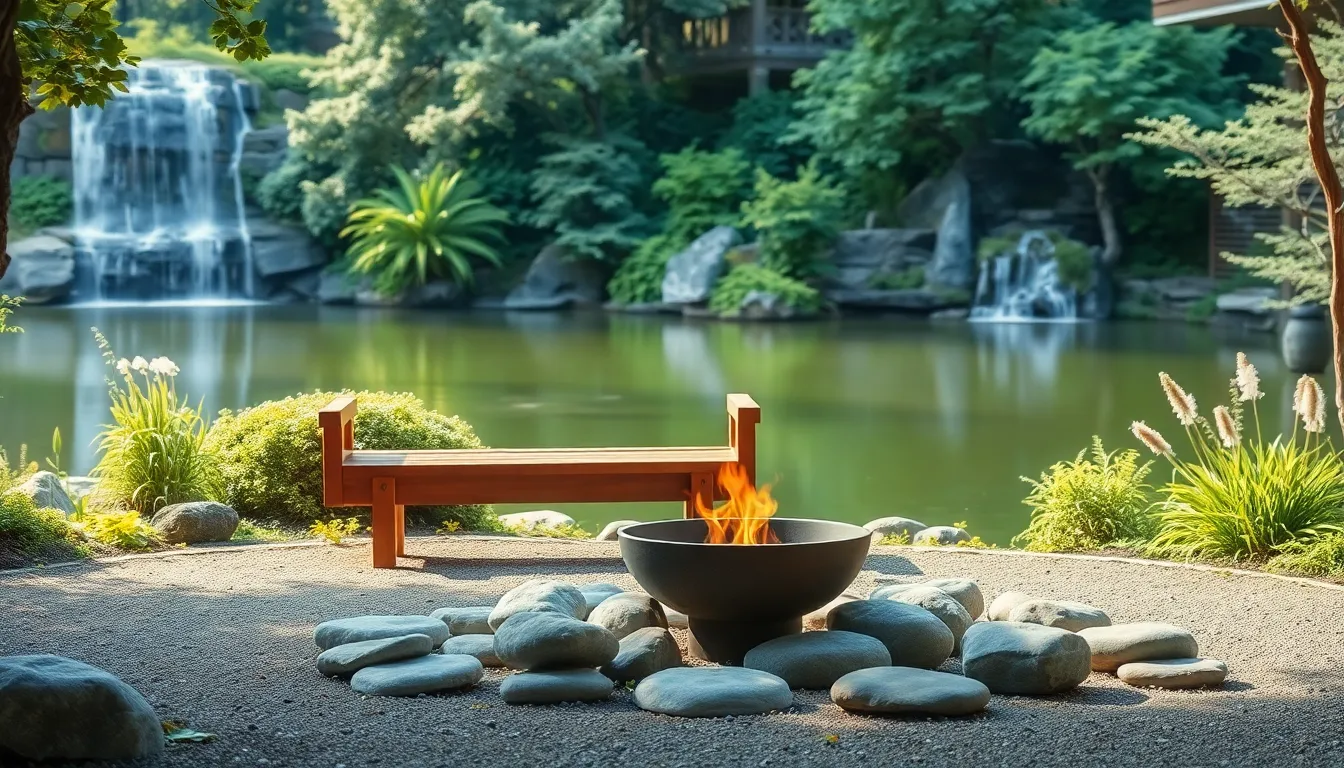
Creating dedicated spaces for quiet reflection transforms your Japanese garden into a true sanctuary for the mind and spirit. We’ll explore how strategic seating placement enhances the contemplative experience while maintaining harmony with traditional design principles.
Install Wooden Benches Near Water Features
Position wooden benches within 3-5 feet of ponds or waterfalls to maximize the soothing effects of flowing water sounds. We recommend using natural cedar or teak that weathers beautifully over time and complements the organic aesthetic of your garden. Place benches at slight angles rather than directly facing water features to create more intimate viewing perspectives and encourage longer meditation sessions.
Solar-powered fountains near seating areas provide continuous gentle sounds that mask urban noise while creating a peaceful atmosphere conducive to contemplation. Install benches on stable stone foundations or wooden platforms that elevate them slightly above ground level for better drainage and comfort. Consider adding small side tables made from matching wood materials to hold tea cups or meditation accessories during extended sitting sessions.
Create Stone Seating Around Fire Bowls
Arrange natural stone seating in a semicircle around fire bowls to provide warmth and ambiance during cooler evening meditation sessions. We suggest using flat river rocks or carved stone blocks that retain heat well and offer comfortable surfaces for extended sitting. Space individual stone seats 2-3 feet apart to maintain personal meditation space while fostering a sense of community when sharing the area with others.
Fire bowls add an unexpected element that bridges traditional Japanese serenity with practical comfort needs in varying climates. Position these seating arrangements in sheltered areas protected from strong winds that might disrupt the flame or create smoke issues. Choose fire bowls with clean geometric lines that echo the minimalist aesthetic found throughout authentic Japanese garden design.
Position Meditation Spots With Mountain Views
Design meditation areas that incorporate borrowed scenery principles by framing views of distant mountains or created rock formations within your garden space. We recommend establishing these spots on slightly elevated ground or terraced areas that provide clear sightlines to natural or constructed mountain representations. Install simple cushioned mats or low wooden platforms that encourage proper meditation posture while maintaining connection to the earth.
Align seating positions with the natural contours of your industry to create seamless integration between meditation spaces and surrounding garden elements. Use strategically placed rocks and mounds to represent mountains when natural views aren’t available, ensuring these artificial features appear weathered and naturally positioned. Screen meditation spots with carefully pruned evergreens or bamboo to provide privacy while maintaining openness to mountain vistas that inspire contemplation and inner peace.
Maintain Balance Through Asymmetrical Design Elements
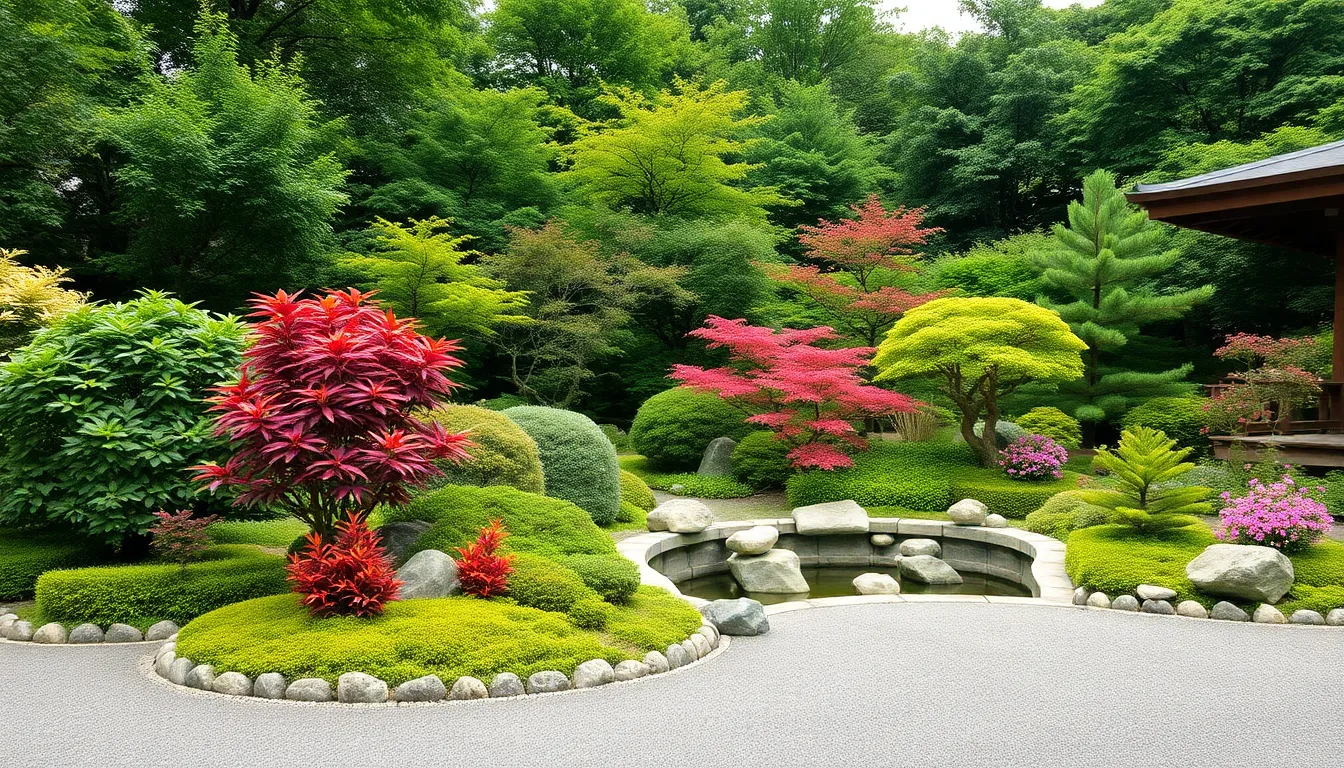
Japanese gardens embrace the art of asymmetrical design, creating harmony through thoughtful imbalance rather than perfect symmetry. We achieve this visual equilibrium by positioning elements along diagonal sight lines instead of straight axes.
Arrange Plants in Odd-Numbered Groupings
Grouping plants in sets of three, five, or seven creates the most natural and visually appealing arrangements in Japanese garden design. We follow this traditional aesthetic principle because odd numbers prevent the eye from creating symmetrical patterns that feel artificial.
Placing three Japanese maples at varying heights establishes a primary focal point, while five azalea bushes can form a secondary grouping nearby. Seven smaller plants like hostas or ferns work perfectly as understory elements beneath larger specimens. This approach mimics how plants naturally cluster in wild settings, where perfect pairs rarely occur.
Create Visual Weight With Strategic Plant Placement
Strategic placement of larger plants serves as visual anchors that balance lighter elements throughout the garden space. We position substantial trees or bold shrubs on one side, then offset their visual weight with complementary features like stone arrangements or water elements on the opposite side.
A mature Japanese maple near the garden’s entrance can be balanced by a grouping of carefully placed boulders or a small pond in the distance. Dense bamboo groves create strong vertical presence that we counterbalance with horizontal elements such as low stone walls or raked gravel areas. This technique maintains equilibrium without creating mirror images that would feel forced or unnatural.
Balance Open Spaces With Dense Plantings
Contrasting open areas with densely planted sections creates visual breathing room and guides movement through the garden. We alternate between moss covered clearings or raked sand areas and thick groupings of shrubs or trees to establish rhythm and flow.
Open spaces allow visitors to pause and appreciate individual garden elements, while dense plantings create mystery and encourage exploration along winding paths. Concealing certain features behind plantings and revealing them gradually enhances the sense of discovery that defines authentic Japanese garden experiences. This interplay between revelation and concealment maintains visitor engagement while honoring traditional design principles.
Conclusion
Creating a Japanese garden transforms your outdoor space into a living masterpiece that celebrates the timeless balance between nature and human artistry. We’ve explored how every element—from tranquil water features and thoughtfully placed stones to seasonal plantings and meditation spaces—works together to create an atmosphere of peace and reflection.
The beauty of Japanese garden design lies in its adaptability to any space and its emphasis on asymmetrical harmony rather than perfect symmetry. Whether you’re incorporating a simple bamboo fountain or designing an elaborate koi pond your garden will become a sanctuary that changes with the seasons.
As you begin your Japanese garden journey remember that patience and mindful planning are key. Each element you add should serve both aesthetic and spiritual purposes creating a space where you can find tranquility and connect with nature’s enduring wisdom.
Frequently Asked Questions
What are the essential elements of a Japanese garden?
The essential elements include tranquil water features (koi ponds, bamboo fountains, streams), carefully designed pathways with stepping stones, traditional plants like Japanese maples and bamboo, stone arrangements following Zen principles, and focal points such as stone lanterns and tea houses. These elements work together to create harmony between human creativity and nature.
How do I create water features for my Japanese garden?
Start with a koi pond using natural stone edges, add a bamboo water fountain for soothing sounds, or design a small stream using river rocks following natural contours. Maintain proper water quality with aquatic plants and ensure optimal placement for both visual appeal and functionality in your garden design.
What plants work best in Japanese gardens?
Japanese maples provide stunning seasonal colors, bamboo groves offer privacy and gentle sounds, and moss groundcover creates lush green carpets. For seasonal interest, add cherry blossoms for spring beauty, azaleas for vibrant summer colors, and Japanese camellias for winter blooms. Plant in odd-numbered groupings for natural appeal.
How should I design pathways in a Japanese garden?
Use stepping stones placed at comfortable intervals with natural moss growth, complement with gravel sections representing water in Zen philosophy, and create curved walkways from natural flagstone. Avoid straight lines and leave gaps for plants to grow, creating a softer, more organic aesthetic that encourages meditation.
What role do rocks and stones play in Japanese garden design?
Rocks serve as meditation anchors reflecting natural harmony. Arrange weathered stones in odd-numbered groupings, create dry landscapes (Karesansui) with raked gravel representing flowing water, and build stone retaining walls for terraced areas. These elements provide structure while maintaining the garden’s tranquil and harmonious atmosphere.
How can I create seating areas for contemplation?
Position wooden benches near water features using natural materials like cedar or teak. Place benches at angles for intimate views, create stone seating around fire bowls for warmth, and design meditation spots that frame scenic views. Integrate natural contours and provide privacy with carefully pruned plants.
Why is asymmetrical design important in Japanese gardens?
Asymmetrical design creates visual balance through thoughtful imbalance rather than perfect symmetry. Arrange plants in odd-numbered groupings, use larger plants as visual anchors, and balance open spaces with dense plantings. This approach creates rhythm, flow, and maintains visitor engagement while honoring traditional design principles.

